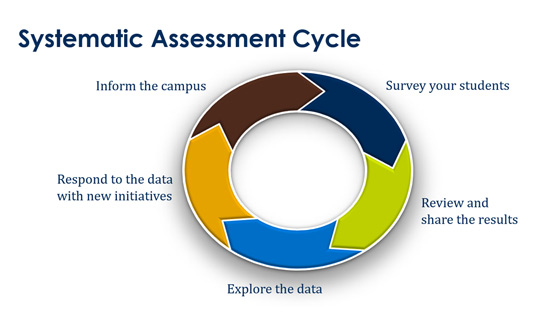student success
Using Actionable Surveying to Drive Student Success
How can you use student satisfaction survey data to take action for improving the student experience? This was the topic of our RNL LinkedIn Live discussion on January 25.
Our guest was Nancy Ludwig, dean of graduate, online, and professional studies at the University of Massachusetts Lowell. Nancy has more than three decades of experience in higher education working for and consulting to both large and small four-year private and public institutions. She has conducted student satisfaction assessments at various institutions as well as in her current role at a four-year public university.
Request feedback with sincerity

“It is important to understand what students want and to have touchpoints to help keep them on track,” Nancy said. She noted that this is especially important with online learning environments when students are not physically on campus to connect face-to-face with the university. Nancy’s team makes a point of providing encouragement to students along the way in addition to sharing reminders about resources and actions that the students need to take. She often hears how much students appreciate being reached out to. Nancy has also found that student satisfaction surveys are an important way to engage with students and to receive feedback on their experience. Asking for student feedback through satisfaction assessments is an opportunity to show students that you care about them and about their experience. It allows you to position the surveys as a way for them to tell you what is working, what is not working and what they think can be improved upon at the institution. You can share with students that you are conducting the surveys because you want to know how you can help them to have the very best experience while they are enrolled. It is then critical to show the students that you care enough to be responsive to the issues that they think need your attention.
As the Systemic Assessment Cycle visual illustrates, satisfaction assessment is a cyclical process. Surveying students is not enough—the data need to be shared, explored and responded to with specific initiatives. And it’s just as important to communicate what’s been done and why, especially before you survey again. When students know that you are using the data to improve their experience, they are more likely to want to provide feedback.
Socialize your satisfaction data to spur improvements on campus
Nancy shared the importance of actively socializing the data on campus. “I make a point of talking about the surveys before and while they are administered within and across divisions at the institution.” Nancy likes to connect a student satisfaction data point or two that is relevant to the agenda in the meetings she is attending. She also noted that she intentionally shares data in bite-size nuggets to create an appetite for more data. “This builds interest and a willingness to dig in more.” Nancy encourages her team to summarize data results with just one or two pages because she feels more than that is getting too deep into the weeds. Connecting data points that are relevant for departments and for particular demographic subpopulations being served also makes the data more interesting, relevant, and actionable.
But don’t forget about communicating with your most important population, your students! Connecting the dots between what the students said on the survey to the actions you take is key to improving satisfaction at your institution. The results don’t need to be distributed all at once but can be parsed out at relevant times. For example, you can:
- Talk about improvements to the registration process and student satisfaction in this area when it is time to register for classes.
- Share a data point about academic advising when you are encouraging students to schedule appointments with their advisors.
- Talk about student satisfaction with the “tuition paid being worthwhile” when balances are due.
Sharing the data when you want to highlight where you have made improvements or where students are already highly satisfied will help create awareness of the efforts that are being made on their behalf.
Addressing areas of challenge
The RNL philosophy with the identification of strengths and challenges in the Satisfaction-Priorities Surveys is one of continuous quality improvement. Every campus has areas to celebrate and every campus has areas for improvement. Certain issues will rise to the top and some departments, like financial aid or advising, may feel like they are in the “hot seat” when students prioritize them for attention. The best approach is to recognize that the data give the institution the opportunity to provide more resources in that area because it matters to students. Nancy noted that when they have data that indicate something needs to be fixed and they have the ability to fix it internally, they then need to be willing to confront it. “We know everyone is working hard and that they care about our students. We get people involved in creating solutions to the issues, so we can make progress on problem areas. This is a way for us to actively show students how much we care.”
“Contemporary learners”
Nancy used the term “contemporary learners” to describe students of today. She said it is important to realize that for decades institutions have been serving traditional-age students in brick and mortar establishments. As online learning has expanded, in part because of the pandemic, we can no longer look at online learners through the lens of the students who have been served in the past. “If we are looking at our students with the wrong lens, we won’t understand what they really need.” Surveying student satisfaction, with instruments that capture their particular experience (like the Priorities Survey for Online Learners) is one way to listen to these students and to truly understand how we can best serve them.
Watch the LinkedIn Live discussion and reach out to talk about assessing your students
You can watch the 30-minute Linked In Live session to hear more from Nancy Ludwig and my colleague Shannon Cook. You will learn more about how you can take action with student satisfaction survey data to positively impact student success.
And if you want to learn more about how you can assess student satisfaction and turn that data into successful initiatives, contact us and we’ll schedule a time to talk.
Complimentary consultation on student satisfaction assessment
Talk to our satisfaction assessment experts about how you can easily implement the survey on your campus, including when is the best time to survey and how to get strong completion rates.
